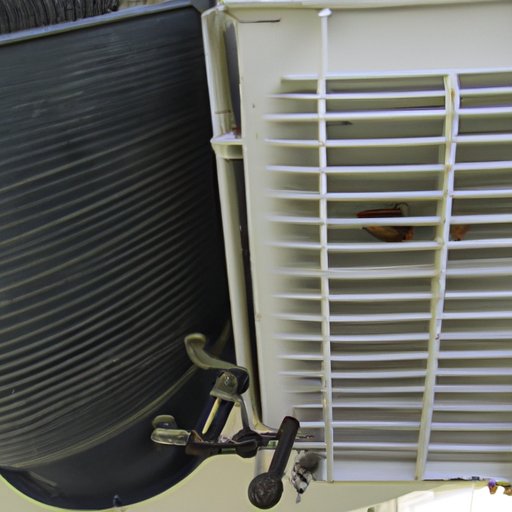Introduction
A swamp cooler, also known as an evaporative cooler, is a type of air conditioner that uses the process of evaporation to cool down the air in a room. While it is not as efficient or powerful as traditional air conditioners, swamp coolers are a cost-effective and energy-efficient alternative for keeping your home cool during hot summer months. In this article, we will explore how does a swamp cooler work, from the science behind its operation to the maintenance tips for optimal performance.

Exploring the Science Behind Swamp Coolers
The basics of how a swamp cooler works are relatively simple. A fan draws warm air into the swamp cooler, which then passes through wet pads. The water evaporates from the pads and cools the air, which is then blown out by the fan into the room. This process is known as evaporative cooling, and it is how swamp coolers are able to effectively cool down a space without using much energy.
Understanding the evaporative cooling process is essential to comprehending how a swamp cooler works. When water evaporates, it takes energy away from the environment in the form of heat. This energy is called the latent heat of vaporization. As the water evaporates, the air around it is cooled down. This is why you feel a cool breeze when standing near a lake or other body of water on a hot day. The same principle applies to swamp coolers, except they use a fan to draw the air into the cooler and spread the cool air throughout the room.
A Step-by-Step Guide to Understanding How Swamp Coolers Work
If you’re looking to install a swamp cooler in your home, there are several steps you need to take in order to understand how it works. Here is a step-by-step guide to understanding how swamp coolers work:
Identifying the Parts of a Swamp Cooler
The first step is to identify the different parts of a swamp cooler. Most swamp coolers consist of a fan, a motor, a water pump, a reservoir tank, and a set of wet pads. The fan is responsible for drawing the warm air into the cooler, while the motor powers the fan. The water pump is used to circulate the water through the wet pads, which are made of a special material that allows them to absorb and hold large amounts of water. Finally, the reservoir tank stores the water that is used to fill the wet pads.
Setting Up and Installing a Swamp Cooler
Once you have identified the different parts of a swamp cooler, the next step is to set up and install the unit. This typically involves mounting the fan to the wall, connecting the motor to a power source, filling the reservoir tank with water, and attaching the wet pads to the fan. Depending on the size and type of swamp cooler you have, the installation process may vary slightly.
Operating a Swamp Cooler
Once you have installed the swamp cooler, the final step is to operate it. To do this, simply turn on the power switch and adjust the fan speed. The water pump will then start circulating the water through the wet pads, causing them to evaporate and cool the air. You can adjust the fan speed depending on how cool you want the air in the room to be.

Comparing Swamp Coolers to Other Cooling Systems
When considering whether or not a swamp cooler is right for your home, it is important to compare them to other cooling systems. There are several benefits to using a swamp cooler, such as their low cost, energy efficiency, and portability. Additionally, swamp coolers are more environmentally friendly than traditional air conditioners, as they don’t release any harmful gases into the atmosphere.
However, there are some drawbacks to using a swamp cooler. For example, they are not as effective at cooling down a room as traditional air conditioners. Additionally, they require regular maintenance in order to keep them running efficiently, such as cleaning and replacing the wet pads. Furthermore, swamp coolers are not suitable for humid climates, as the evaporative cooling process will not work if the air is already saturated with moisture.

The Pros and Cons of Using a Swamp Cooler
In conclusion, there are both advantages and disadvantages to using a swamp cooler. On the one hand, they are a cost-effective and energy-efficient way to cool down a room. They also don’t release any harmful gases into the atmosphere, making them an environmentally friendly option. On the other hand, they are not as effective as traditional air conditioners and require regular maintenance.
Maintaining Your Swamp Cooler for Optimal Performance
In order to get the most out of your swamp cooler, it is important to maintain it regularly. This includes regularly cleaning the wet pads and replacing them when necessary. Additionally, it is important to check the water level in the reservoir tank and refill it when needed. It is also recommended to inspect the fan blades for signs of wear and tear, as well as checking the motor for any damage.
Conclusion
In this article, we explored how does a swamp cooler work. We discussed the science behind evaporative cooling, as well as the steps for setting up and operating a swamp cooler. We also compared swamp coolers to other cooling systems and discussed the pros and cons of using one. Finally, we outlined some tips for maintaining your swamp cooler for optimal performance. With this knowledge, you should now have a better understanding of how a swamp cooler works and how to get the most out of it.
(Note: Is this article not meeting your expectations? Do you have knowledge or insights to share? Unlock new opportunities and expand your reach by joining our authors team. Click Registration to join us and share your expertise with our readers.)
